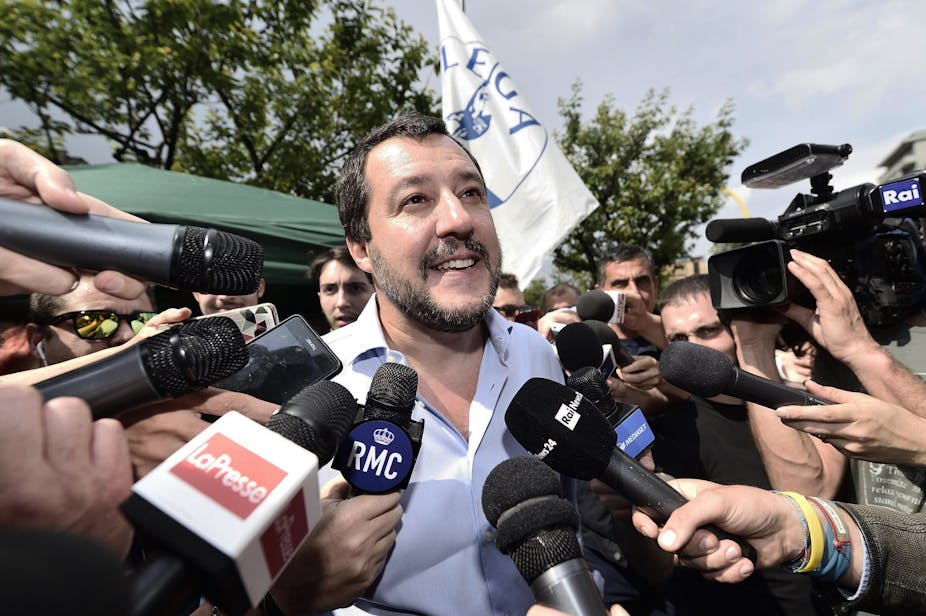The regional Italian populist movement, the Northern League, was in crisis six years ago. Although it served as a junior coalition partner in four of Silvio Berlusconi’s governments between 1994 and 2011, the party was then severely damaged by a corruption scandal in 2012 which forced the resignation of its founder and leader, Umberto Bossi. When the current leader, Matteo Salvini, took control of the party in 2013, it was polling at between 4% and 5%.
Fast forward to 2018 and amid a deepening political crisis, Salvini’s rebranded League is on the verge of becoming Italy’s largest party – polling at 27.5%.
This swift upturn in fortunes is largely due to Salvini’s “revolution”, which has turned the League into one of the leading populist movements in Europe, claiming to protect Italian sovereignty against the perceived European “elites”. Salvini has sharpened the party’s stances on anti-immigration and law and order, while abandoning the Northern League’s historic cause of regionalism and federalism.
In doing so, he has brought an end to a second wave of north Italian regionalism which began in the early 1980s.
Two waves of regional activism
A first wave of north Italian regional activism started in the 1950s, with the creation of movements for regional autonomy. In Piedmont, there was the Movement for Piedmontese Regional Autonomy (MARP) and in Lombardy, the Movement for Bergamascan Autonomy (MAB). In the 1980s, a second wave of activism then emerged in the north – of regionalist leagues, which acted under the umbrella term the “Northern League” between 1992 and 2017. These two successive waves were different – specific to the historic context at the time – yet connected by their focus on regional politics.
The movements for regional autonomy in Piedmont and Lombardy had advocated for national unity but also campaigned for the activation of regional statutes in the constitution. The Northern League instead campaigned for an overhaul of these statutes in order to bring in “fiscal federalism”, in which any savings made through a reduction in state public expenditure would be redistributed in a way that would benefit the northern regions, rather than the whole country. Such a policy rejected the principle of national solidarity, and was just a key example of how the Northern League challenged the role of the nation state in ways which would have been anathema to its predecessors.
Still, the anti-southern, anti-centralist and anti-Roman rhetoric that had emerged in the first wave of activism was later recycled by the Northern League.
Padania and North Italian autonomy
One particular common denominator between both waves of regionalist activism was the term “Padania”, which referred in varying degrees to a homogenous north Italian zone.
In 1958, MARP and MAB had formed an electoral alliance called MARPadania (Movement for Padanian Regional Autonomy), which became the first political representation of Padania in a national election. Padania then reemerged in the 1970s when the Union of Italian Autonomists, an offshoot of MAB, campaigned under the banner of “Padania Libera” (Free Padania).

In the late 1990s, Bossi’s Northern League embarked on a strategy of secessionism, and for the first time in the history of north Italian regionalism, made a declaration of Independence for Padania. The imaginary state of Padania emphasised a stereotypical split between the hard-working north and parasitic and lazy south.
The Northern League abandoned seccesionism in 1999 and embraced “devolution”, but Padania was preserved as the symbol of the party and obtaining independence was still its nominal objective.
In his first speech as a secretary of the Northern League, Salvini invoked Padania and secessionism, but he also later set up a separate movement entitled “Us with Salvini” in order to campaign for votes in southern regions. By adopting the slogan “Italians first”, Salvini began to appeal to all of Italy and not just the north – one of the first signs of a post-regional approach.
Sacrificing Padania to save The League

Salvini’s announcement in 2017 that he would remove the words Padania and Nord from all symbols of the movement represented a watershed moment. “Padania”, as a symbol of regional autonomy, does not work alongside the League’s “Italians first!” slogan: it specifically attacked the south of the peninsula, which is where Salvini aims to gain more votes. A reference to “autonomy and responsibility” in Salvini’s electoral programme for the March 2018 elections was the only lip service paid to the party’s traditional cause of regional autonomy.
The two clear winners of these elections were the Five Star Movement and the League. While Five Star triumphed in the south, the centre-right coalition, made up of the League, Forza Italia and Fratelli d'Italia dominated the north. For the first time in the history of this centre right coalition, the League gained more votes (17.63%) than Forza Italia (14.43%).
The League’s larger vote share was, however, partly due to the total of 987,406 votes that it received in the central-southern regions. For Salvini – a man who has a long history of insulting southern Italians with labels such as “parasites” – to win 23 deputies from the south is proof of how effective his revolution has been.
This marks the end of the second wave of regional activism in northern Italy. The irony is that by abandoning his party’s original identity Salvini stands to become the most successful and influential leader in its history.

